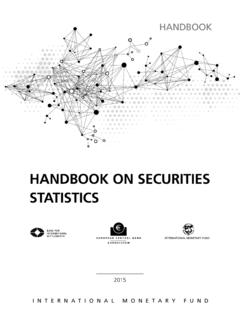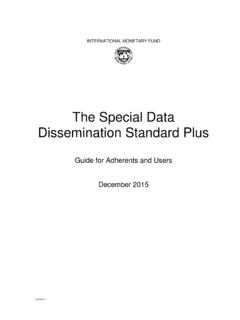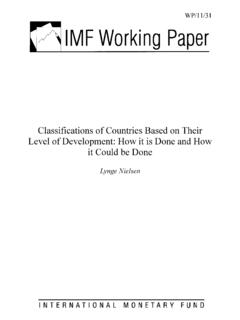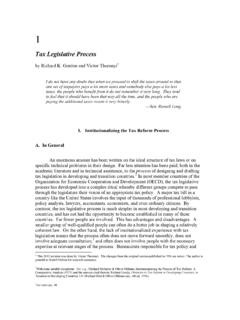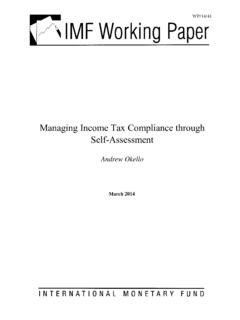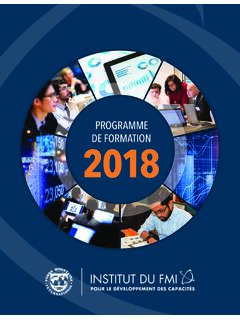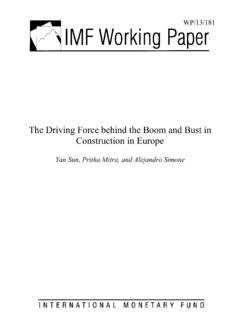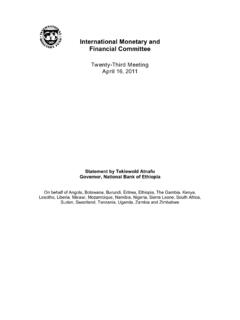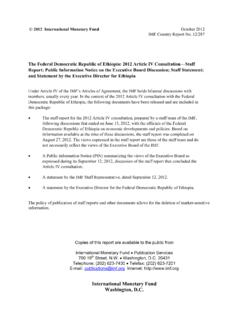Transcription of Revenue Mobilization in Developing Countries
1 INTERNATIONAL MONETARY FUND Revenue Mobilization in Developing Countries Prepared by the Fiscal Affairs Department Approved by Carlo Cottarelli March 8, 2011 Contents Page Abbreviations and Acronyms ..3 Executive Summary ..4 I. Introduction ..6 II. Aims, Trends, and Possibilities ..6 A. Objectives and Context ..7 B. Similarities, Differences, and Strategies for Reform.
2 8 C. Trends and Recent Experience ..12 D. Assessing the Scope to Raise More Revenue ..16 III. Issues and Lessons ..17 A. core administration Reforms ..19 B. The Value-Added Tax (VAT) ..23 C. Trade Liberalization and Customs administration ..28 D. Personal Income Taxation ..31 E. Taxing Corporations ..33 F. Excises ..37 G. Taxing Small Businesses ..39 H. Real Estate Taxation ..41 IV. Institutions and Transparency ..42 V. Issues for Discussion ..45 Table Features by Income Group ..25 Figures 1. Revenue -Related and Other Structural Benchmarks, 2002 10.
3 11 2. Trends in Total and Tax Revenue 1980 2009 ..12 2 3. Receipts from Natural Resources, averages 2000 07 ..13 4. Tax Revenue Developments in Resource-Rich and Other Countries , 1980 2009 ..14 5. Tax Revenue Developments by Region, 1980 2009 ..15 6. Distribution of the Tax Ratio in Developing Countries , 1990 95 and 2003 08 ..15 7. Trends in the Composition of Revenues, 1980 2009 ..16 8. The Spread of the VAT, 1980 2009 ..24 9. Benefits from Zero-Rating Relative to Income Shares, Mexico ..26 10. Developments in Trade Tax Revenue and Collected Tariff Rates, 1980 2009.
4 28 11. Developments in Tax Revenue and Trade Tax Revenue , 1980 2009 ..29 12. Developments in Corporate Tax Rates and Revenues, 1980 2009 ..34 13. Developments in Excise Revenues, 1980 2008 ..37 Boxes 1. Common Elements of Strategies for Reform ..10 2. The Regional Perspective ..15 3. Aid, Resource Wealth, and Revenue Mobilization ..16 4. Key Challenges for Tax Reform ..18 5. The Distributional Impact of Exemptions and Reduced Rates ..26 Appendices I. Technical Assistance on Tax Matters ..46 II. Tax Reform in Post-Conflict and Successor States ..48 III.
5 Data ..50 IV. Understanding Tax Performance and Effort ..56 V. Estimating Tax Effort ..59 VI. Strong Performers Three Examples ..63 VII. Taxing Natural Resources Issues and Principles ..66 VIII. Estimated Revenue Gains from Increasing VAT Efficiency ..68 IX. Zambia: Building and Maintaining a VAT ..70 X. Dangers of Tax Holidays ..71 XI. Regional Agreement on Corporate Taxation Possible XII. Experience with Unilateral Removal of Tax Incentives ..74 Appendix Tables 2. Summary 3. Fixed Country Grouping ..55 4. Estimated Tax Effort ..60 5. VAT Efficiency by Income Group.
6 68 Appendix Figure 14. Revenue administration and Tax Policy Mission Intensity, FY2008 10 ..46 References ..753 ABBREVIATIONS AND ACRONYMS CEMAC Communaut conomique des tats d Afrique Centrale CIT Corporate Income Tax EAC East African Community ECOWAS Economic Community of West African States FAD Fiscal Affairs Department IT information technology HR
7 Human Resources LIC Low-Income Country LMIC Lower Middle-Income Country LTO Large Taxpayer Office PIT Personal Income Tax RA Revenue Authority SACU Southern African Customs Union SIC Social Insurance Contributions SOE State-Owned Enterprise TPC Tax Procedures Code VAT Value-Added Tax UMIC Upper Middle-Income Country WAEMU West African Economic and Monetary
8 Union WCO World Customs Organization WTO World Trade Organization 4 EXECUTIVE SUMMARY The Fund has long played a lead role in supporting Developing Countries efforts to improve their Revenue Mobilization . This paper draws on that experience to review issues and good practice, and to assess prospects in this key The need for additional Revenue is substantial in many Developing Countries , but improving Revenue Mobilization has importance beyond that.
9 Requirements for relieving poverty and improving infrastructure are substantial: achieving the Millennium Development Goals, for instance, may require low-income Countries to raise their tax-GDP ratios by around 4 percentage points (United Nations, 2005). But the quality of measures also matters: increasing Revenue by further taxing readily compliant taxpayers can worsen distortions and perceived inequities; conversely, reducing reliance on trade taxes can bring real structural gains that outweigh short-term Revenue difficulties. More fundamentally still, the centrality of taxation in the exercise of state power means that more efficient, fairer, and less corrupt tax systems can spearhead improvement in wider governance relations.
10 Experience shows that progress can be made given strong political will. There have been disappointments: in some areas of advice (such as early espousal of the global income tax) and in country practice (the use made of improved IT systems, for instance). But several Countries have significantly improved their tax performance over relatively short periods, and econometric analysis (comparing performance in differing Countries ) suggests that many lower-income Countries could increase their tax ratios by 2 4 percent of GDP. A common element of success stories is sustained political commitment at the highest levels: even administrative reforms can prompt strong opposition.

